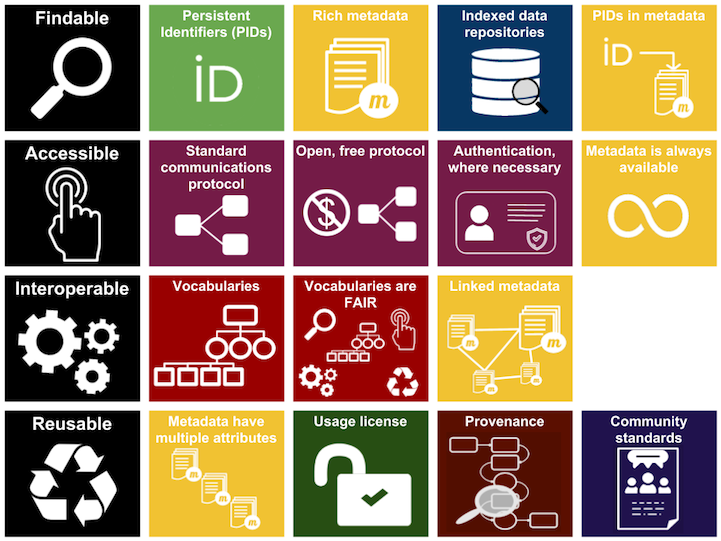User:Shawndouglas/sandbox/sublevel12
|
|
This is sublevel12 of my sandbox, where I play with features and test MediaWiki code. If you wish to leave a comment for me, please see my discussion page instead. |
Sandbox begins below
Title: What are the potential implications of the FAIR data principles to laboratory informatics applications?
Author for citation: Shawn E. Douglas
License for content: Creative Commons Attribution-ShareAlike 4.0 International
Publication date: May 2024
Introduction
This brief topical article will examine
Blah blah blah
First discussed during a 2014 workshop dedicated to "overcoming data discovery and reuse obstacles," the FAIR Guiding Principles were published by Wilkinson et al. in 2016 as a stakeholder collaboration driven to see research "objects" (i.e., research data and information of all shapes and formats) become more universally findable, accessible, interoperable and reusable (FAIR) by both machines and people.[1] The authors released the FAIR principles while recognizing that "one of the grand challenges of data-intensive science ... is to improve knowledge discovery through assisting both humans and their computational agents in the discovery of, access to, and integration and analysis of task-appropriate scientific data and other scholarly digital objects."[1]
Since 2016, other research stakeholders have taken to publishing their thoughts about how the FAIR principles apply to their fields of study and practice[2], including in ways beyond what perhaps was originally imagined by Wilkinson et al.. For example, multiple authors have examined whether or not the software used in scientific endeavors itself can be considered a research object worth being developed and managed in tandem with the FAIR data principles.[3][4][5][6]
- LIMS and FAIR: Journal:A roadmap for LIMS at NIST Material Measurement Laboratory
- ELNs and FAIR: Structure-based knowledge acquisition from electronic lab notebooks for research data provenance documentation
- Biomedical software and FAIR: https://www.nature.com/articles/s41597-023-02463-x
- Making software workflows FAIR: https://www.ncbi.nlm.nih.gov/pmc/articles/PMC10538699/
- AWS and FAIR for healthcare and life sciences: https://aws.amazon.com/blogs/industries/implement-fair-scientific-data-principles-when-building-hcls-data-lakes/
- APIs and FAIR data: https://www.labguru.com/blog/fair-data-principles-and-apis
- Bioinformatics LIMS and FAIR: https://www.ncbi.nlm.nih.gov/pmc/articles/PMC8425304/
- Labbit: https://labbit.com/fair-data-lims
- https://riojournal.com/article/96075/ Importance of metadata for FAIR data objects
- Deep talk about metadata: Journal:Shared metadata for data-centric materials science
- More metadata, for findability: "While descriptive metadata may not be available, support for generalized CRUD operations requires essential structural and administrative metadata to be captured, stored, and made available for requestors. Metadata capture must be highly automated and reliable, both in terms of technical reliability and ensured metadata quality." Journal:Making data and workflows findable for machines
- More metadat, for reusability: "make recommendations for assigning identifiers and metadata that supports sample tracking, integration, and reuse. Our goal is to provide a practical approach to sample management, geared towards ecosystem scientists who contribute and reuse sample data." Journal:Sample identifiers and metadata to support data management and reuse in multidisciplinary ecosystem sciences
- "The principles should be considered during development of informatics systems to further promote data discovery and reuse. In Table 1, we have correlated the various BRICS functional components to the FAIR principles to illustrate the extent to which each of the components contributes towards the principles." Journal:Development of an informatics system for accelerating biomedical research
Restricted or personal information while still being FAIR
- Journal:FAIR Health Informatics: A health informatics framework for verifiable and explainable data analysis
- Journal:Restricted data management: The current practice and the future
- Linking databases of data that haven't seen proper "FAIR-ification" and metadata handling won't be as useful.
- Further discussion on data quality in the scope of FAIR: Journal:Towards a contextual approach to data quality
Conclusion
References
- ↑ 1.0 1.1 Wilkinson, Mark D.; Dumontier, Michel; Aalbersberg, IJsbrand Jan; Appleton, Gabrielle; Axton, Myles; Baak, Arie; Blomberg, Niklas; Boiten, Jan-Willem et al. (15 March 2016). "The FAIR Guiding Principles for scientific data management and stewardship" (in en). Scientific Data 3 (1): 160018. doi:10.1038/sdata.2016.18. ISSN 2052-4463. PMC PMC4792175. PMID 26978244. https://www.nature.com/articles/sdata201618.
- ↑ "fair data principles". PubMed Search. National Institutes of Health, National Library of Medicine. https://pubmed.ncbi.nlm.nih.gov/?term=fair+data+principles. Retrieved 30 April 2024.
- ↑ Gruenpeter, M. (23 November 2020). "FAIR + Software: Decoding the principles" (PDF). FAIRsFAIR “Fostering FAIR Data Practices In Europe”. https://www.fairsfair.eu/sites/default/files/FAIR%20%2B%20software.pdf. Retrieved 30 April 2024.
- ↑ Barker, Michelle; Chue Hong, Neil P.; Katz, Daniel S.; Lamprecht, Anna-Lena; Martinez-Ortiz, Carlos; Psomopoulos, Fotis; Harrow, Jennifer; Castro, Leyla Jael et al. (14 October 2022). "Introducing the FAIR Principles for research software" (in en). Scientific Data 9 (1): 622. doi:10.1038/s41597-022-01710-x. ISSN 2052-4463. PMC PMC9562067. PMID 36241754. https://www.nature.com/articles/s41597-022-01710-x.
- ↑ Patel, Bhavesh; Soundarajan, Sanjay; Ménager, Hervé; Hu, Zicheng (23 August 2023). "Making Biomedical Research Software FAIR: Actionable Step-by-step Guidelines with a User-support Tool" (in en). Scientific Data 10 (1): 557. doi:10.1038/s41597-023-02463-x. ISSN 2052-4463. PMC PMC10447492. PMID 37612312. https://www.nature.com/articles/s41597-023-02463-x.
- ↑ Du, Xinsong; Dastmalchi, Farhad; Ye, Hao; Garrett, Timothy J.; Diller, Matthew A.; Liu, Mei; Hogan, William R.; Brochhausen, Mathias et al. (6 February 2023). "Evaluating LC-HRMS metabolomics data processing software using FAIR principles for research software" (in en). Metabolomics 19 (2): 11. doi:10.1007/s11306-023-01974-3. ISSN 1573-3890. https://link.springer.com/10.1007/s11306-023-01974-3.










